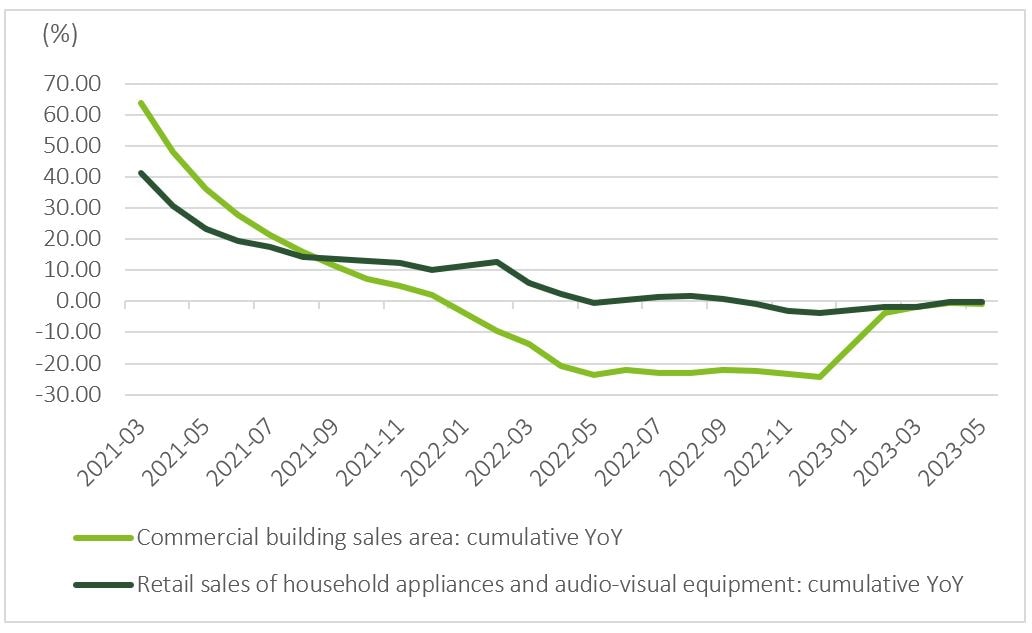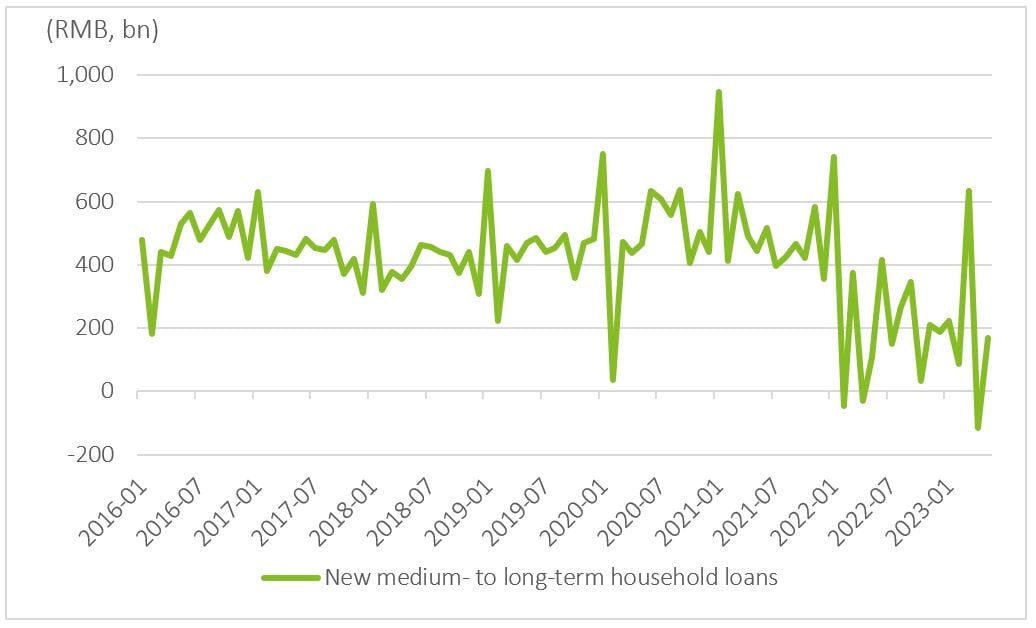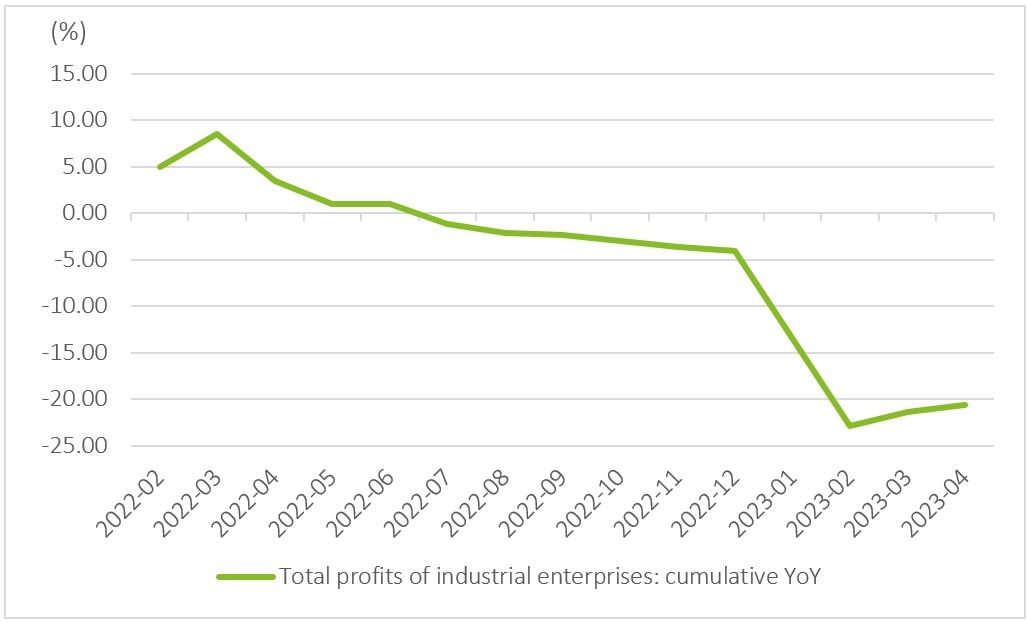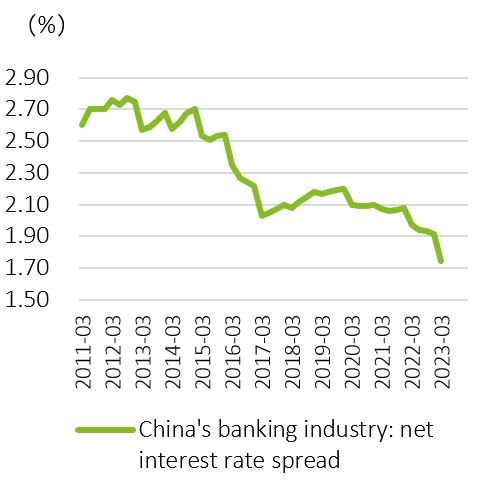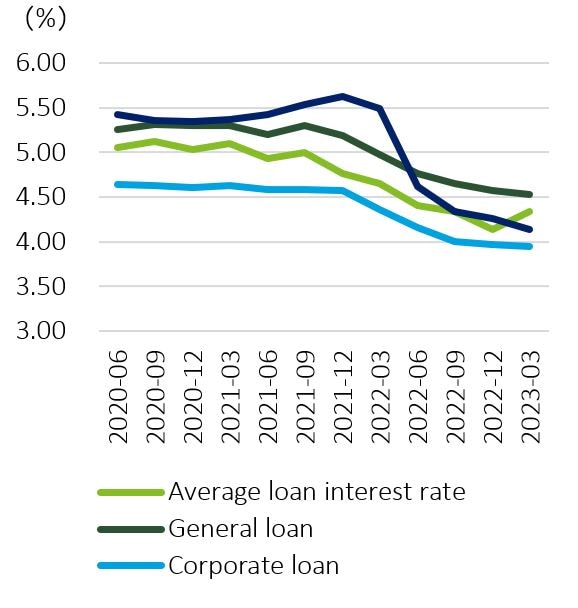Perspectives
The Deloitte Research Monthly Outlook and Perspectives
Issue 83
Published date: 21 June 2023
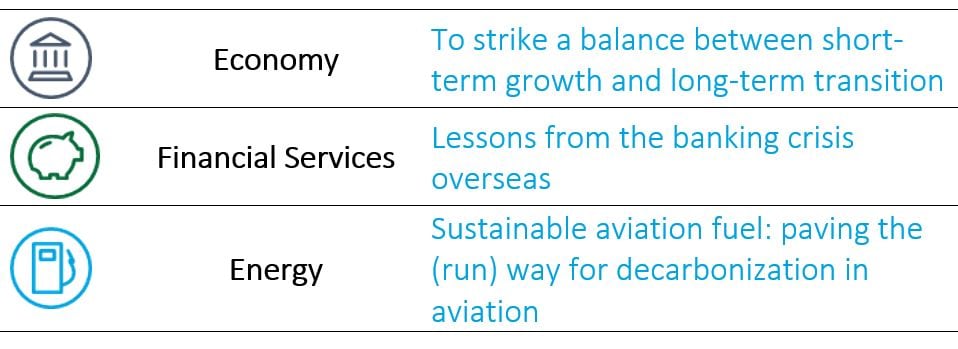
Economy
To strike a balance between short-term growth and long-term transition
Is the pace of economic recovery decelerating? If the answer is affirmative, what are the feasible solutions? A slew of economic indicators since April appear to suggest that the robust rebound observed since the advent of the Chinese New Year is starting to lose momentum. This has sparked intensifying anticipation for stimulus measures. Our view, however, is that China does not require an ambitious fiscal stimulus plan. Instead, we firmly believe in calibrated supportive policies geared towards the housing market – the position we've maintained all along.
Despite the prevailing circumstances where major central banks (primarily the Federal Reserve and the European Central Bank) have not yet completed their tightening cycle, we strongly advocate for further monetary easing. A more flexible Renminbi exchange rate is not only a necessary instrument for amplifying the efficacy of monetary policy but also instrumental in bolstering export competitiveness.
Let's delve into the recent data releases. The housing sector's slowdown is anticipated. Despite considerable improvement in their financial circumstances, most developers lack the impetus to escalate investment. The government, since last November, has initiated an array of measures aimed at stabilizing the struggling property market. These initiatives have proven sufficient to circumvent a systemic crisis and to nudge highly-leveraged developers to complete their unfinished projects, but fall short in compelling them to spur their investment efforts. This cautious approach, echoed by homebuyers' reluctance to increase their leverage, is placing a burden on growth.
Chart: Slowdown of housing activities weighs on consumption
Source: Wind, Deloitte Research
The challenge lies in identifying supplementary sources of growth in the long term without the impetus of a thriving property market. However, it will require time for future growth sectors such as new energy, AI, or advanced manufacturing to emerge. In the short term, we believe stabilizing the residential property market, which is intimately connected with consumer wealth, should be prioritized. This pertains to maintaining a balance between short-term growth and the longer-term economic transition.
The conundrum, however, is figuring out the 'how.' In theory, lower interest rates should stimulate the housing market. Yet, consumers have predominantly chosen to refinance their mortgages due to uncertainty surrounding the government's housing policy, while at least refinancing could mitigate interest expenses. This explains the PBOC's seemingly cautious approach to interest rate cuts. The market has been anticipating such a rate cut for a considerable period, given the absence of inflation risk. The PBOC's prudent stance on interest rates further emphasizes its commitment to avoiding a prolonged period of ultra-low interest rates due to the potential risk of financial system bubbles.
Chart: Mortgage decelerated on consumers’ cautions
Source: Wind, Deloitte Research
Furthermore, the Fed's tightening cycle has influenced PBOC's interest rate decisions. The Fed's decision to defer the rate hike at its June FOMC meeting was interpreted by the market as a "hawkish pause," indicating the potential for two more rate hikes in the latter half of 2023. Widening interest rate differentials between the dollar and the RMB have recently pushed USD/CNY to 7.2, a level unseen since November 2022. In summary, while the PBOC is likely to maintain an easing bias in its monetary policy, an aggressive rate cut seems unlikely due to a hawkish Fed, a bullish dollar, and already low interest rates.
So, in the absence of significantly lower interest rates, what should be the primary policy instrument to stabilize the housing market? On numerous occasions, policymakers have highlighted unfulfilled demand for better quality housing as a key catalyst to unleash domestic demand. Meeting such demand necessitates a boost in consumer confidence, which in turn would translate into a higher number of mortgages and thus increased demand for basic housing. Essentially, the trickle-down effect could rejuvenate the housing market. In our perspective, such a trickle-down effect must be anchored by the removal of various restrictive measures in major cities (first-tier cities), where pent-up demand is robust and demographic factors are favorable. If the lifting of such distortions could infuse vitality into first-tier cities, a selective pilot program of property tax could be undertaken.
When considering this pent-up demand in terms of economic aggregate, it is largely a reflection of China's saving rate (45%, highest in the world) and consumer leverage (63%, lower than most countries). High savings rates and low consumer leverage suggest a low risk of forced selling even when housing inventory accumulates. In simpler terms, it is highly unlikely that China will experience a sub-prime meltdown.
Assuming that a combination of lower interest rates and credible policy assurances addressing the demand for improved housing needs could stabilize the property market, should further fiscal stimulus be implemented? In contrast to 2008, most developed economies are currently at risk of a slowdown, while strong labor markets continue to keep inflation stubbornly high. Concurrently, the ongoing conflict between Ukraine and Russia continues to cast a pall over energy and commodity prices. Therefore, a significant fiscal stimulus in infrastructure may have several drawbacks - 1) the existing high leverage in the corporate sector; 2) a surge in commodity prices, which could be driven higher by such a stimulus, potentially eroding industrial profits; 3) the risk of exacerbating protectionism and geopolitical threats if firms are compelled to offload their products in overseas markets.
Chart: Industrial profits squeeze is compounded by weak demand
Source: Wind, Deloitte Research
Considering the need to address inadequate aggregate demand, the central government must assume more debt. Ideally, any additional debt undertaken by the central government should target local governments that are heavily reliant on fiscal revenues from land auctions through direct transfers, as well as low-income consumers.
In conclusion, with a moderate fiscal stimulus – but more importantly, credible actions aimed at lifting housing demand restrictions in first-tier cities and a more flexible RMB exchange rate – we believe that the target of "around 5%" GDP growth for 2023 remains achievable.
Financial Services
Lessons from the banking crisis overseas
The failure of the Silicon Valley Bank (SVB) in March was followed by a series of bank failures in the US and Europe which led to a noticeable tightening of credit and a consequent rise in interest rates. This has exposed fault-lines in the financial markets - huge fluctuations in market interest rates, poor business operations, and rising investor risk aversion during the transition of monetary policy from quantitative easing to tightening. The question is, will the crisis affect China’s domestic banking sector? What are the lessons that regulators and financial institutions should learn?
The banking crisis could have a spillover effect on the real economy
For now, the banking crisis appears to have been contained but its effects will be felt for the next several months. Small and medium-sized banks (SMBs) will be at greater risk due to the ongoing credit crunch which will lead to increasing pressure on enterprises to repay debts, increasing the chances of a spill over effect on the real economy, and credit defaults.
According to the World Bank, a (systemic) banking crisis is marked by an increase in non-performing loans, fluctuations in risky asset prices, a rise in real interest rates, and a slowdown in capital flows. Recently, U.S. home prices in April posted the largest YoY decline since 2012. The FED’s Financial Stability Report in May lists "banking sector stress" and "persistent inflation and monetary tightening" as the two most prominent risks to the real economy.
Tight prudential supervision for SMBs is compulsory
The US and European banking crisis have had no substantial spill over effect on the Chinese banking system thanks to the very different financial structures in the two systems. However, the Covid pandemic has left no nation untouched, and risks have accumulated in every country's financial system, differing only in terms of form of evolution and degree of impact.
SVB was a non-systemically important SMB in the US, mainly absorbing deposits from technology venture capital firms. But because it had invested in bonds, there was a severe duration mismatch between its investments and its obligations. When monetary policy tightened, interest rate risk caused investments to incur unrealized losses. SVBs investors got spooked and this rapidly evolved into a liquidity risk. The root cause of this can be traced back to the 2018 regulatory rollback in the US in which the threshold for Systemically Important Financial Institutions (SIFIs) was raised to USD 250 billion in total assets. SVB, with total assets of USD 211.8 billion at the end of 2022, was below this threshold, and hence was exempt from regular liquidity stress tests, and no needs to meet stringent requirements on Liquidity Coverage Ratio (LCR) and Net Stable Funding Ratio (NSFR).
Baoshang Bank and Jinzhou Bank are two regional banks which can be viewed as similar in size and scale to SVB. In recent years, China’s SMBs have also faced threats of capital erosion due to poor risk management, shaky real estate financing, shareholder-related transactions and shadow banking. The People's Bank of China's recent Banking Stress Tests report has warned that SMB loans to small, medium, and micro enterprises and individual businesses need to be vetted carefully and customer concentration, interbank counterparties, and real estate financing should also be checked.
SMB reform and risk reduction is the main task of the newly established National Administration of Financial Regulation (NAFR). The newly issued Financial Stability Law has already issued rules on industrial guarantee funds and market-based asset disposal. But the specific application of these rules is still to be tested.
Stabilizing interest spreads is top priority for Chinese banks
The root cause of SVB’s liquidity risk was a significant duration mismatch between assets and liabilities that occurred when the average duration of HTM (Held to Maturity) bonds rose to 6.2 years at the end of 2022, while 93% of liabilities were mainly below 1 year. Compared with the US, Chinese banks have longer deposit durations, especially because SMBs mainly rely on a longer period of maturity to absorb deposits. Also, China's benchmark interest rate is more stable, thus there is comparatively less fluctuation in bond duration and hence less liquidity risk.
However, the NIM (net interest margin) ratio, which is the ratio of net interest income to interest-earning assets, an important indicator of bank profitability, has been falling, becoming as a result the main pressure point in China’s banking system. Since 2020, due to wave after wave of credit easing, falling lending rates, weak credit demand and intense price competition have meant that banks’ NIM ratios have decreased, falling below 2% for the first time at the end of 2022. This year was worse as NIM ratios fell further to 1.74% in Q1, below the alert line of 1.8%. Recently quite a few banks have lowered their deposit rates, aiming to stabilize their net interest rate spreads.
In the second half of 2023, as credit supply and demand balance out, we expect the spread narrowing process to slow down with less negative drag on net profit.
Chart: banking spread falling to historically low |
Chart: loan interest rates continue falling |
Source: Wind, PBoC, NAFR
However, in the medium to long term, bank spreads narrowing to a low level could probably become the norm. Banks should carefully review their portfolios for risk of non-performing assets accumulated during the Covid pandemic, pay close attention to spread compression due to asset-liability mismatch, and instead, give priority to intermediary businesses and to exploring new avenues in wealth management, asset management, pension business and so forth.
Energy
Sustainable aviation fuel: paving the (run) way for decarbonization in aviation
With the disruption caused by the pandemic having all but subsided, global travel is expected to rebound to 80 to 90 percent of pre-pandemic levels in 2023. China has witnessed a surge in travel during the May Day Holiday, with the first-day number of passengers surpassing 150% of the level of 2019 on the same day.
This has revived pressure on the aviation sector to reduce its nearly 1Gt of annual CO2 emissions. Today, the aviation sector alone accounts for roughly 3% of global CO2 emissions. Through a commitment to the International Air Transport Association (IATA), the aviation sector has committed itself to Net Zero by 2050. This has made it imperative to accelerate the decarbonisation of the Aviation sector. Of all the possible ways to cap aviation emissions here, a gradual shift to sustainable aviation fuels is considered the most promising way ahead in the medium term.
What is sustainable aviation fuel?
Sustainable aviation fuel (SAF) is generally made from feedstocks ranging from waste oil, fats, municipal waste, and agriculture residues to synthesize hydrogen and captured CO2. SAF is a “drop-in fuel”, which means it can be mixed with fossil fuels directly to power airplanes without requiring any major modification in existing engines and infrastructure.
SAF can play a critical role in decarbonizing the aviation sector. Compared to fossil jet fuel, SAF has been demonstrated to result in up to 80% reduction in CO2 emission.
High cost hinders wider adoption
The usage of SAF in the aviation sector was only around 0.1% to 0.15% of total jet fuel in 2022. However, according to IEA’s Sustainable Development Scenario (SDS), SAF needs to make up 10% of aviation fuel demand by 2030, and nearly 20% by 2040.
The main obstacle to achieving these targets is the high cost of SAF. Fossil jet fuel costs about USD 800 per tonne, whereas SAF can cost 2 to 8 times as much, depending on the type of feedstock used and its level of technological maturity.
This cost disparity has resulted, so far, in a significant production gap -- while the target set for its production capacity is 23 billion liters by 2030, the production capacity in 2022 stood only at 300~450 million liters, representing a shortfall of tens of billions of liters.
Chart: Global SAF required 2025-2040
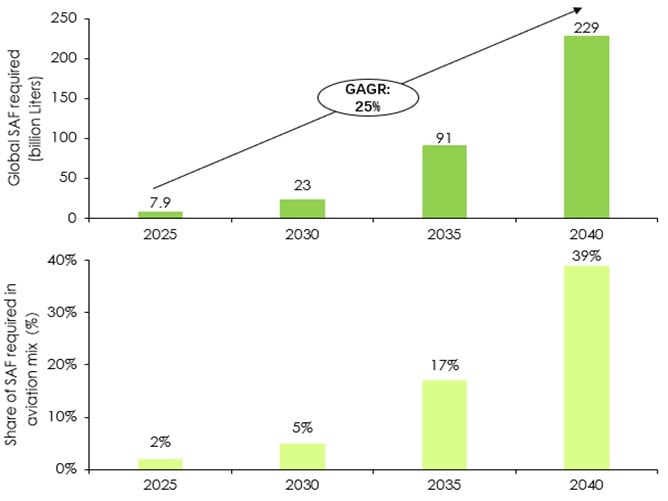
Source: IATA
Regulatory landscape expands
Europe and the U.S. are actively promoting SAF. For example, the European Commission released a set of legislative recommendations dubbed "Fit for 55" in July 2021. The Refuel E.U. Aviation initiative, which seeks to increase SAF production and adoption, is one part of the package. In accordance with the plan, aviation fuel suppliers will be required to ensure that all fuels delivered to aircraft operators at E.U. airports contain a minimum percentage of SAF. The mandate is anticipated to begin in 2025 with a minimum volume of 2% SAF, rising in five-year increments to a minimum volume of 63% in 2050, of which 28% would be synthetic aviation fuels.
U.S. Congress introduced The Sustainable Skies Act in May 2021 with the goal of increasing incentives for SAF use. Blenders that furnish SAF with evidence of lifecycle greenhouse gas (GHG) savings of 50% or more will receive a credit starting at USD 1.50 per gallon. Higher GHG achievement will result in a credit of up to a maximum of 2 USD per gallon. This will amount to almost $480 per tonne of aviation fuel. With the purpose of increasing the number of SAF production facilities in the U.S., a complementary proposal also includes a grant of $1 billion over five years.
China has set its own SAF consumption goal but it needs to follow this up with concrete programs and incentives to achieve the goal. The 14th Five-Year Plan for the Green Development of Civil Aviation issued by the Civil Aviation Administration of China said that it is necessary to implement a low-carbon development strategy, promote breakthroughs in the commercial application of SAF, and strive to achieve an SAF consumption of over 20,000 tons by 2025.
Rapid expansion of SAF ecosystem in China
Recently, Airbus forecast that China’s air traffic will grow at 5.3% annually, faster than the world average of 3.6% over the next 20 years. Meeting this demand will require 8,420 passenger and freight aircraft between now and 2041. That will represent more than 20% of the world’s total demand.
China’s low carbon transition imperative has brought it more attention from a range of players in the SAF field. These include energy producers, technology providers, aircraft companies and airlines. China provides a suitable location in which to test and apply many of the pioneering technologies and solutions being developed today.
In April, Airbus signed MOUs with several Chinese local partners, including the China National Aviation Fuel Group (CNAF) to collaborate in the production, application, and formulation of Common Standards for Sustainable Aviation Fuels. Earlier, in September 2022, Airbus and CNAF had entered into a contract to support commercial and delivery flights in China operated with SAF in the future. By the end of March 2023, 17 cargo delivery flights and a first commercial flight had been flown, using some proportion of SAFs, by the two partners. The new collaboration aims to optimize the SAF supply chain by diversifying the sources and enhancing SAF production with the goal of using 10% of SAF by 2030.
Honeywell too has signed several MOUs with local partners in China. One of these is with the Tianjin Free Trade Zone, in which the two have agreed to explore opportunities for SAF production in northern China’s Tianjin Municipality. In addition, it has previously announced cooperation with Zhejiang Jia’ao Enprotech Stock Co Ltd. to build an SAF production facility in Jiangsu Province, which will utilize kitchen waste oil and animal fat as raw materials to produce the SAF.
With more than 20,000 commercial aircraft in service today, and with those aircraft typically having a lifespan of 30 years, SAF will have to play a large part in reducing CO2 emissions in the medium term. Commercializing new technologies in the high-tech industry takes time, and the same applies to SAF production. Currently, the production of alternative fuels remains limited due to their much higher costs. But, as the industry develops and the scale of production rises, competition will force prices down, and increase both the supply and acceptability of sustainable alternative fuels.

